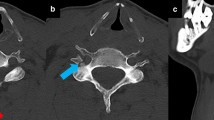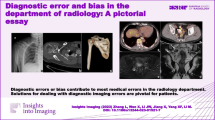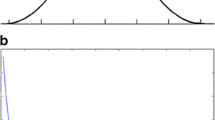Abstract
The objective of this paper is to explore sources of diagnostic error in musculoskeletal oncology and potential strategies for mitigating them using case examples. As musculoskeletal tumors are often obvious, the diagnostic errors in musculoskeletal oncology are frequently cognitive. In our experience, the most encountered cognitive biases in musculoskeletal oncologic imaging are as follows: (1) anchoring bias, (2) premature closure, (3) hindsight bias, (4) availability bias, and (5) alliterative bias. Anchoring bias results from failing to adjust an early impression despite receiving additional contrary information. Premature closure is the cognitive equivalent of “satisfaction of search.” Hindsight bias occurs when we retrospectively overestimate the likelihood of correctly interpreting the examination prospectively. In availability bias, the radiologist judges the probability of a diagnosis based on which diagnosis is most easily recalled. Finally, alliterative bias occurs when a prior radiologist’s impression overly influences the diagnostic thinking of another radiologist on a subsequent exam. In addition to cognitive biases, it is also important for radiologists to acknowledge their feelings when making a diagnosis to recognize positive and negative impact of affect on decision making. While errors decrease with radiologist experience, the lack of application of medical knowledge is often the primary source of error rather than a deficiency of knowledge, emphasizing the need to foster clinical reasoning skills and assist cognition. Possible solutions for reducing error exist at both the individual and the system level and include (1) improvement in knowledge and experience, (2) improvement in clinical reasoning and decision-making skills, and (3) improvement in assisting cognition.






Similar content being viewed by others
References
Itri JN, Patel SH. Heuristics and cognitive error in medical imaging. Am J Roentgenol. 2018;210:1097–105.
Bruno MA, Walker EA, Abujudeh HH. Understanding and confronting our mistakes: the epidemiology of error in radiology and strategies for error reduction. Radiographics. 2015;35:1668–76.
Rozenberg A, Kenneally BE, Abraham JA, Strogus K, Roedl JB, Morrison WB, Zoga AC. Clinical impact of second-opinion musculoskeletal subspecialty interpretations during a multidisciplinary orthopedic oncology conference. J Am Coll Radiol. 2017;14:931–6.
Chalian M, Grande FD, Thakkar RS, Jalali SF, Chhabra A, Carrino JA. Second-opinion subspecialty consultations in musculoskeletal radiology. Am J Roentgenol. 2016;206:1217–21.
Kahneman D Thinking, fast and slow, 1st ed. Farrar, Straus and Giroux, New York
Brady AP. Error and discrepancy in radiology: inevitable or avoidable? Insights Imaging. 2017;8:171–82.
Busby LP, Courtier JL, Glastonbury CM. Bias in radiology: the how and why of misses and misinterpretations. Radiographics. 2018;38:236–47.
Croskerry P, Singhal G, Mamede S. Cognitive debiasing 1: origins of bias and theory of debiasing. Bmj Qual Saf. 2013;22:ii58–64.
Onder O, Yarasir Y, Azizova A, Durhan G, Onur MR, Ariyurek OM. Errors, discrepancies and underlying bias in radiology with case examples: a pictorial review. Insights Imaging. 2021;12:51.
Waite S, Scott J, Gale B, Fuchs T, Kolla S, Reede D. Interpretive error in radiology. Am J Roentgenol. 2017;208:739–49.
Blumenthal-Barby JS, Krieger H. Cognitive biases and heuristics in medical decision making. Med Decis Making. 2014;35:539–57.
Kumar B, Ferguson K, Swee M, Suneja M. Diagnostic reasoning by expert clinicians: what distinguishes them from their peers? Cureus. 2021;13:e19722.
Tversky A, Kahneman D. Judgment under uncertainty: heuristics and biases. Science. 1974;185:1124–31.
Korteling JE, Brouwer A-M, Toet A. A neural network framework for cognitive bias. Front Psychol. 2018;9:1561.
Pohl RF. Cognitive illusions: intriguing phenomena in thinking, judgment and memory. 2nd ed. Psychology Press; 2016.
Dimara E, Franconeri S, Plaisant C, Bezerianos A, Dragicevic P. A task-based taxonomy of cognitive biases for information visualization. Ieee T Vis Comput Gr. 2018;26:1413–32.
Berlin L. Alliterative errors. Am J Roentgenol. 2000;174:925–31.
Liu G, Chimowitz H, Isbell LM. Affective influences on clinical reasoning and diagnosis: insights from social psychology and new research opportunities. Diagnosis. 2022. https://doi.org/10.1515/dx-2021-0115.
Kandasamy N, Garfinkel SN, Page L, Hardy B, Critchley HD, Gurnell M, Coates JM. Interoceptive ability predicts survival on a London trading floor. Sci Rep-uk. 2016;6:32986.
Riskin A, Erez A, Foulk TA, Riskin-Geuz KS, Ziv A, Sela R, Pessach-Gelblum L, Bamberger PA. Rudeness and medical team performance. Pediatrics. 2017;139:e20162305.
Croskerry P, Campbell SG. A cognitive autopsy approach towards explaining diagnostic failure. Cureus. 2021;13:e17041.
Norman GR, Monteiro SD, Sherbino J, Ilgen JS, Schmidt HG, Mamede S. The causes of errors in clinical reasoning. Acad Med. 2017;92:23–30.
Graber ML, Kissam S, Payne VL, Meyer AND, Sorensen A, Lenfestey N, Tant E, Henriksen K, LaBresh K, Singh H. Cognitive interventions to reduce diagnostic error: a narrative review. Bmj Qual Saf. 2012;21:535.
Rozenberg A, Kenneally BE, Abraham JA, Strogus K, Roedl JB, Morrison WB, Zoga AC. Second opinions in orthopedic oncology imaging: can fellowship training reduce clinically significant discrepancies? Skeletal Radiol. 2019;48:143–7.
Stacy GS, Dixon LB. Pitfalls in MR image interpretation prompting referrals to an orthopedic oncology clinic1. Radiographics. 2007;27:805–26.
Bedoya MA, Chi AS, Harsha AK, Oh SC, Cook TS. Musculoskeletal outside interpretation (MOI-RADS): an automated quality assurance tool to prospectively track discrepancies in second-opinion interpretations in musculoskeletal imaging. Skeletal Radiol. 2021;50:723–30.
Rupani A, Hallin M, Jones RL, Fisher C, Thway K, Verhoef C. Diagnostic differences in expert second-opinion consultation cases at a tertiary sarcoma center. Sarcoma. 2020;2020:9810170.
Hartley LJ, Evans S, Davies MA, Kelly S, Gregory JJ. A daily diagnostic multidisciplinary meeting to reduce time to definitive diagnosis in the context of primary bone and soft tissue sarcoma. J Multidiscip Healthc. 2021;14:115–23.
Shah A, Botchu R, Ashford RU, Rennie WJ. Diagnostic triage for sarcoma: an effective model for reducing referrals to the sarcoma multidisciplinary team. Br J Radiology. 2015;88:20150037.
Davis DA, Thomson MA, Oxman AD, Haynes RB. Changing physician performance: a systematic review of the effect of continuing medical education strategies. JAMA. 1995;274:700–5.
Lee CS, Nagy PG, Weaver SJ, Newman-Toker DE. Cognitive and system factors contributing to diagnostic errors in radiology. Am J Roentgenol. 2013;201:611–7.
Croskerry P, Singhal G, Mamede S. Cognitive debiasing 2: impediments to and strategies for change. Bmj Qual Saf. 2013;22:ii65–72.
Feyzi-Behnagh R, Azevedo R, Legowski E, Reitmeyer K, Tseytlin E, Crowley RS. Metacognitive scaffolds improve self-judgments of accuracy in a medical intelligent tutoring system. Instr Sci. 2014;42:159–81.
Lambe KA, O’Reilly G, Kelly BD, Curristan S. Dual-process cognitive interventions to enhance diagnostic reasoning: a systematic review. Bmj Qual Saf. 2016;25:808.
Lex J, Gregory J, Allen C, Reid J, Stevenson J. Distinguishing bone and soft tissue infections mimicking sarcomas requires multimodal multidisciplinary team assessment. Ann Royal Coll Surg Engl. 2019;101:405–10.
Neuhaus C, Lutnæs DE, Bergström J. Medical teamwork and the evolution of safety science: a critical review. Cognition Technology Work. 2020;22:13–27.
Al-Ibraheemi A, Folpe AL. Voluntary second opinions in pediatric bone and soft tissue pathology. Int J Surg Pathol. 2016;24:685–91.
Lurkin A, Ducimetière F, Vince DR, et al. Epidemiological evaluation of concordance between initial diagnosis and central pathology review in a comprehensive and prospective series of sarcoma patients in the Rhone-Alpes region. BMC Cancer. 2010;10:150–150.
Ray-Coquard I, Montesco MC, Coindre JM, et al. Sarcoma: concordance between initial diagnosis and centralized expert review in a population-based study within three European regions. Ann Oncol. 2012;23:2442–9.
Wolf M, Krause J, Carney PA, Bogart A, Kurvers RHJM. Collective intelligence meets medical decision-making: the collective outperforms the best radiologist. PLoS ONE. 2015;10:e0134269.
Author information
Authors and Affiliations
Corresponding author
Ethics declarations
Conflict of interest
The authors declare no competing interests.
Additional information
Publisher’s note
Springer Nature remains neutral with regard to jurisdictional claims in published maps and institutional affiliations.
Key points
• Diagnostic errors are more likely to be cognitive than perceptual in oncologic imaging.
• Knowledge and experience reduce the likelihood of errors.
• Multidisciplinary diagnostic teams may reduce errors if group interactions are optimized.
• Individuals and groups should learn to recognize impact of cognitive bias and adopt strategies such as force functions to mitigate their impact.
Rights and permissions
Springer Nature or its licensor holds exclusive rights to this article under a publishing agreement with the author(s) or other rightsholder(s); author self-archiving of the accepted manuscript version of this article is solely governed by the terms of such publishing agreement and applicable law.
About this article
Cite this article
Flemming, D.J., White, C., Fox, E. et al. Diagnostic errors in musculoskeletal oncology and possible mitigation strategies. Skeletal Radiol 52, 493–503 (2023). https://doi.org/10.1007/s00256-022-04166-7
Received:
Revised:
Accepted:
Published:
Issue Date:
DOI: https://doi.org/10.1007/s00256-022-04166-7




